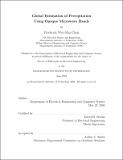| dc.contributor.author | Chen, Frederick Wey-Min | |
| dc.date.accessioned | 2004-06-16T19:17:52Z | |
| dc.date.available | 2004-06-16T19:17:52Z | |
| dc.date.issued | 2004-06-16T19:17:52Z | |
| dc.identifier.uri | http://hdl.handle.net/1721.1/5415 | |
| dc.description.abstract | This thesis describes the use of opaque microwave bands for global estimation of
precipitation rate. An algorithm was developed for estimating instantaneous precipitation
rate for the Advanced Microwave Sounding Unit (AMSU) on the NOAA-15,
NOAA-16, and NOAA-17 satellites, and the Advanced Microwave Sounding Unit and
Humidity Sounder for Brazil (AMSU/HSB) aboard the NASA Aqua satellite. The
algorithm relies primarily on channels in the opaque 54-GHz oxygen and 183-GHz
water vapor resonance bands. Many methods for estimating precipitation rate using
surface-sensitive microwave window channels have been developed by others.
The algorithm involves a set of signal processing components whose outputs are
fed into a neural net to produce a rain rate estimate for each 15-km spot. The signal
processing components utilize techniques such as principal component analysis for
characterizing groups of channels, spatial filtering for cloud-clearing brightness temperature
images, and data fusion for sharpening images in order to optimize sensing
of small precipitation cells. An effort has been made to make the algorithm as blind
to surface variations as possible.
The algorithm was trained using data over the eastern U.S. from the NEXRAD
ground-based radar network, and was validated through numerical comparisons with
NEXRAD data and visual examination of the morphology of precipitation from over
the eastern U.S. and around the world. It performed reasonably well over the eastern
U.S. and showed potential for detecting and estimating falling snow. However, it
tended to overestimate rain rate in summer Arctic climates.
Adjustments to the algorithm were made by developing a neural-net-based estimator
for estimating a multiplicative correction factor based on data from the Advanced
Microwave Sounding Radiometer for the Earth Observing System (AMSR-E) on the
Aqua satellite. The correction improved estimates in the Arctic to more reasonable
levels. The final estimator was a hybrid of the NEXRAD-trained estimator and the
AMSR-E-corrected estimator.
Climatological metrics were computed over one year during which all AMSU-A/B
instruments on NOAA-15, NOAA-16, and NOAA-17 were working. Annual mean
3
rain rates appear to agree morphologically with those from the Global Precipitation
Climatology Project. Maps of precipitation frequencies and the diurnal variations of
precipitation rate were produce | en |
| dc.description.sponsorship | National Aeronautics & Space Administration under Grant NAG5-7487, Grant NAG5-13652, Grant NAG5-11390, and Contract NAS5-31376. | en |
| dc.format.extent | 3591649 bytes | |
| dc.format.mimetype | application/pdf | |
| dc.language.iso | en | |
| dc.relation.ispartofseries | Technical report (Massachusetts Institute of Technology. Research Laboratory of Electronics);702 | |
| dc.subject | microwave | en |
| dc.subject | algorithm | en |
| dc.subject | microwave sounding radiometer | en |
| dc.subject | hybrid | en |
| dc.title | Global Estimation of Precipitation Using Opaque Microwave Bands | en |
| dc.type | Technical Report | en |
